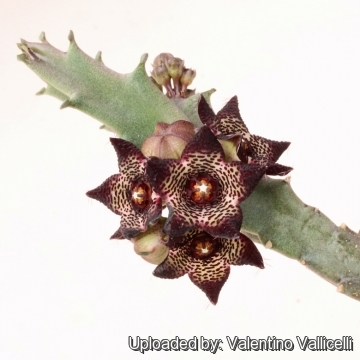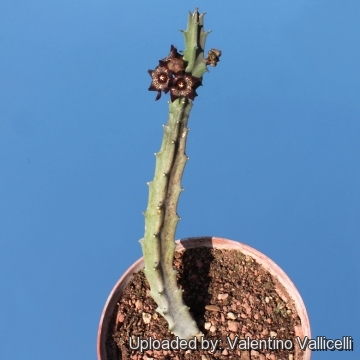




Your support is critical to our success.

Origin and Habitat: Caralluma joannisSN|18990]]SN|18990]] is endemic to south west Morocco in the locality at Aoulouz, at the foot of the High Atlas in the Souss Valley, The locality in Aoulouz seems to be the only known one up to today.
Habitat: It is a rock-dwelling species that grows in the dry forest at the margin of the Sahara desert, exclusively in crevices on vertical limestone cliffs and tends to be pendant. The development in cultivation of stolons could indicate that Caralluma joannisSN|18990]]SN|18990]] once grew on less vertical places with more ground cover. In fact the plants growing in the rock crevices hardly produce stolons.
Synonyms:
- Caralluma joannis Maire
- Apteranthes joannis (Maire) Plowes
Description: Caralluma joannisSN|30729]]SN|18990]] is a nice pendant species, producing hanging dark green stems with clusters of star-shaped, purple flowers in late summer. This is a sister species to Caralluma europaeaSN|1969]]SN|1969]].
Habit: It is a low-growing, widely spreading perennial succulent plant. It branches from the base to form small clumps and may be either erect or pendant (depending on its habitat).
Stems: Branched, four-angled, smooth, with blue-grey, not mottled, 6-20 cm tall or pendent up to 1 m long 1,3-1,5 cm across. with obtuse bombed angles.
Leaves: Rudimentary and ephemeral on stem angles.
Inflorescences: Clustered near stem-apex each with 2 to 14 pedicellate flowers with a
very unpleasant smell .
Flowers: Star-shaped, purple. Pedicel 6-8 mm long. Corolla 1.3-2.5 cm across inner nner surface of corolla glabrous, covered with tubercles giving a rough, warty appearance. Tubercles uniformly dark. Centre of corolla paler, becoming darker towards outer edge. Lobes ovate, acute, spreading. with few fine hairs only on margins near tips, brown or purple. Limb concave with rim higher than corona. pale In olive-yellow with brown or purple warts. hairless. Corona brown or dark purple. cup prominent: outer lobes each or 2 simple teeth less than 1 mm: inner lobes inarched.
Blooming season: Late summer.
Chromosome number: 2n = 66 (it has hexaploid genome, a feature shared by Caralluma burchardiiSN|18990]]SN|30729]] subsp. maura)
Bibliography: Major references and further lectures
1) Christopher Brickell “RHS Encyclopedia of Plants and Flowers” Dorling Kindersley Ltd, 01/Sept/2010
2) James Cullen "The European garden flora: a manual for the identification of plants cultivated in Europe, both out-of-doors and under glass. Dicotyledons (part IV) : [Loganiaceae to Compositae]" Cambridge University Press, 2000
3) American Horticultural Society “The American Horticultural Society encyclopedia of garden plants” Macmillan, 30/Nov/1989
4) Jean-André Audissou “Moroccan Stapeliads” in: Asklepios 94:25 2005
5) Audissou J-A. “Redécouverte de Caralluma joannis. Maire” Cactus Aventures, 23: 19-21 1994
6) Audissou J-A. “In Situ: notes complémentaires sur Caralluma joannis Maire” in Cactus Aventures, 29: 20-21 1996
7) Audissou J-A., Delanoy G. & Manetti M. “Caralluma joannis en culture" In Succulentes
8) 1: 3-8 1998.
9) Jonkers B. & Walker C.C. “The Asclepiads in Morocco. A short commentary.” Asklepios, 59: 14-21 1993
10) Marnier-Lapostolle J. “Les Stapéliées." Cactus 52:127 1956
11) White A. & Sloane B.L. “The Stapeliae” (ed.2), Abbey San Encino Press, vol. 1: 1-407 1937
12) Bensusan K., Lamb B. & Perez C.. “On the distribution and habits of Apteranthes joannis” (Maire) Plowes. In: Asklepios, 104, 3-8. 2009
13) Bensusan K. “Taxonomy and conser vation status of Moroccan stapeliads (Apocynaceae-Asclepiadoideae-Ceropegieae-Stapeliinae)” Bulletin de l’Institut Scientifique, Rabat, section Sciences de la Vie, n°31 (2), 67-77 2009

Caralluma joannis Photo by: Valentino Vallicelli

Caralluma joannis Photo by: Valentino Vallicelli

Caralluma joannis Photo by: Valentino Vallicelli
The gallery now contains thousands of pictures, however it is possible to do even more. We are, of course, seeking photos of species not yet shown in the gallery but not only that, we are also looking for better pictures than those already present. Read More...
Cultivation and Propagation: Caralluma joannisSN|18990]]SN|18990]] is extremely xerophytic and adapted to very dry soils, but despite its provenance it is without doubt an easy species to grow and not difficult as commonly supposed. In cultivation it can be grown as a hanging basket where it will happily flower.
Growth rate: It is a relatively rapidly growing and easily flowering species that will make large clumps given the best conditions. Most plants will offset readily, and clumps can be produced in a few years.
Soils: It likes very porous mineral cactus mix soil, pH 7,5 to 8,5 (mildly alkaline), but can become too elongated if compost is too rich.
Repotting: This plant needs plenty of space for its roots, repotting should be done every other year or when the it has outgrown its pot. Use pot with good drainage.
Watering: It needs regular watering, especially during the hottest summer days; provide also some light watering if the green house temperatures in winter are elevated. Either excessive or very scarce watering can induce rot.
Fertilization: Feed with a high potassium fertilizer in summer.
Frost Tolerance: Reputedly resistant to light frost if kept on the dry side prior to, and during, cold weather (hardy to -2 C ° C, or less for short periods), but for safe cultivation it is best to avoid freezing temperatures. In the rest period no high atmospheric humidity!!
Sun Exposure: Best for half-shade but grow well in full sun and full shade too. Tends to bronze in strong light, which encourages flowering, but is likely to suffer from sun scorch or stunted growth if over exposed to direct sunlight during the hottest part of the day in summer.
Diseases: This species is more resistant to cryptogamic diseases than others and is quite resistant to the “Balck spot” disease of Asclepiads. Rot it is only a minor problem with Caralluma joannisSN|18990]]SN|18990]] if the plants are watered and “aired” correctly. If they are not, fungicides won't help all that much.
Uses: It is an excellent plant for container growing. Cascading, clustering, great for a hanging display. Stems may possibly become purple and limp in winter, but revitalize in early spring. It always looks good and stays small. It look fine in a cold greenhouse and frame or outdoor in a rockery.
Propagation: Seeds and cuttings. Cuttings will root only in hot weather. Cuttings must be kept very dry to root. Seeds germinate readily if they are sown when fresh.
| Your Actions | |
|---|---|
| Back to Caralluma index | |
| Back to Asclepiadaceae index | |
 |
Back to Succulents Encyclopedia index |
Privacy stantement - Terms and conditions - How to cite - About us - Feedback - Donate



